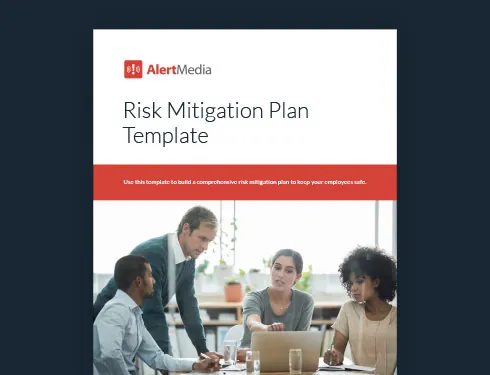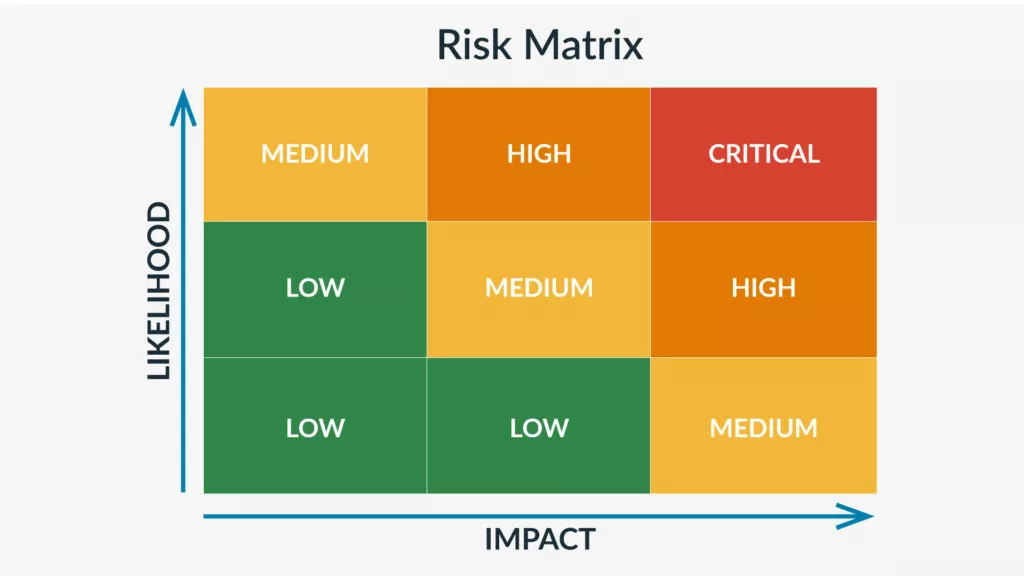
10 Risk Mitigation Strategies & Examples for 2024
While you can’t eliminate all risks, you can take steps to minimize risk and get as close as possible to complete protection. Here are 10 common risk mitigation strategies to help you.

In every organization, regardless of industry or size, some amount of risk is guaranteed. But how you manage that risk can make a huge difference in the results and limit, or even eliminate, any disruptions. When your risk management process can’t prevent a risk from playing out, risk mitigation strategies can help.

For Scott Davidson, CEO and Founder of Code 4—an operations management and emergency services provider based in Austin, Texas—risk mitigation is a key part of how he ensures safety and security during mass events. In an interview for The Employee Safety Podcast, Scott explains, “Even the most thoughtfully planned, well-funded, and longstanding events have a scarcity of resources. We’re limited in bandwidth, time, and, more than ever, the personnel available to mitigate these risks. It means that our job is to really triage and to be futurists, tasked with predicting the future based on our expertise, our experience, and the patterns and trends that we’re observing. We have to identify what risks are worthy and meaningful to mitigate against and knowingly leave some unmitigated. And that’s, as you can imagine, quite a challenge.”
Companies must contend with weather and natural disasters, occupational hazards, cybersecurity threats, supply chain disruptions, and myriad other operational risks. Taken together, managing and mitigating risk is a year-round priority. A Deloitte survey of executives found that 94% of respondents believe risk management is becoming more important to achieving strategic goals.
Risk events come in various forms, and there’s no perfect way to address them. But with planning, preparation, and the right risk management strategy, you can minimize threats to your business. This article will cover 10 risk mitigation strategies and provide examples of how you can implement them.
Download Our Risk Mitigation Plan Template
What is risk mitigation?
Risk mitigation is the process of identifying, analyzing, and acting to reduce or control risks your organization may be exposed to. These risks can stem from a wide range of potential threats, such as natural disasters, economic instability, strategic errors, and more. Effective risk mitigation involves several strategies that can be applied to different risks. The primary aim is not to eliminate all risks but rather to minimize their potential impact on your organization or project.
What Are the Four Types of Risk Response?
If you walked into your office break room and found a toaster on fire, your next moves would be obvious. You’d grab a fire extinguisher, put out the fire, tend to any injuries, and report the incident for cleanup. While this is a simple scenario, it’s an ideal example of risk response. You identified a risk (a fire) and issued an immediate response (extinguishing it).
Most risks your company will face aren’t so simple. That’s where strong organizational risk intelligence comes in. By developing the ability to understand, evaluate, assess, and respond to identified risks, you can prepare your team for nearly any threat.
No single step is more important than the others. But risk response is the make-or-break moment when you put training into action and—hopefully—prevent a hazard from injuring your team members or disrupting operations.
There are four types of risk response:
- Risk avoidance: Sometimes, the best risk response strategy is to eliminate the threat altogether. For example, if employees are traveling into the path of an oncoming hurricane, canceling their trip would avoid that risk.
- Risk transference: You can share or transfer certain types of risk such that you wouldn’t bear the impact alone. An insurance policy is a form of risk transference, as you pay a small fee to a third party to avoid the full financial brunt of things like property damage.
- Risk acceptance: When a risk is small enough, it might make sense to let it play out. For example, if you’re planning an outdoor event with a 15% chance of rain, an acceptance strategy for that very small risk might make more sense than rescheduling. For threats that bring a higher potential impact, you need to determine your acceptable level of risk.
- Risk mitigation: Many types of risk are neither avoidable nor acceptable. But you can mitigate safety and business risks by reducing their likelihood of occurring and/or the impact they could have. For example, an industrial bakery can’t avoid having massive heat sources active, but it can take steps to reduce the danger to employees and property.
Planning and Risk Identification
In an ideal world, you could prepare your organization with a business strategy for any threat it may face. In reality, you have limited time and resources to dedicate to your risk management plan. By assessing risks, you can prioritize your mitigation efforts more effectively and streamline your risk management initiatives.
The key to risk mitigation planning is to identify what risks your business faces and focus on how likely a threat will come to fruition and how much it would impact your business. Perform a risk assessment to determine any potential risks and use a risk matrix to help with visualization and prioritization.

Using this matrix, you would begin with the highest risk level and then work your way down the list to address risks as time and resources allow.
For example, consider an Alaskan king crab boat that regularly works in rough seas and the following possible risks:
- A crewmember going overboard: Given the crew’s working conditions, there’s a high likelihood of this happening. The impact of the risk is high as well, as an incident could potentially lead to death. This is a critical risk, and it would be a top priority to focus on mitigating.
- GPS equipment breaking: As long as the crew maintains its electronics, the likelihood of this happening is low. But an equipment failure would have a moderate impact: The crew would need to navigate using methods with higher margins of error, possibly delaying travel. This would be a medium-level risk, and it would be wise to mitigate it.
- Eggs breaking in the kitchen: In rough conditions, waves can be unpredictable, and eggs could easily end up cracked, so there’s a moderate likelihood of this happening. However, the impact is low, as the crew would almost certainly have other food to eat. And cleanup to avoid slips would be a simple response. This scenario is a low risk, and you can ignore it in favor of more pressing concerns.
10 Types of Risk Mitigation Strategies & Examples
The risk mitigation process isn’t a one-size-fits-all endeavor. Once you understand how to manage your risks, you’ll find that different situations call for different approaches.
Here are 10 effective risk mitigation strategies you can implement to help you make informed decisions and handle various challenges.
1. Challenge the risk
Strategy: You can see some risks ahead of time and monitor them as they evolve. Challenge these risks by allowing them to progress as long as the danger is manageable and negligible. Then cut or slow them before the hazard becomes substantial.
Example: Weather forecasts aren’t perfect, but snowstorms are reasonably predictable. You can challenge the risk by staying open in the days leading up to an impending storm, then closing operations with enough time for your employees to make it home safely.
2. Prioritize your risks
Strategy: A single hazard can pose multiple risks to your business and team. When this happens, you can minimize the impact by prioritizing the risks and dealing with them in order of importance according to your risk matrix.
Example: If you’re responsible for the business continuity plan at a hospital in New Orleans, a hurricane is the sort of threat that keeps you up at night. Prioritizing your risks will speed up decision-making in an emergency. First, you’d ensure patients are cared for and employees are safe. Then, you’d use the remaining time and resources to minimize damage to your facilities and equipment, starting with expensive or hard-to-replace machinery and leaving things like office furniture for last.
3. Exercise the risk
Strategy: Since risks are hazards you’ve already identified, you can exercise them. Run experiments, drills, or tabletop exercises to model threats your team could face and evaluate the effectiveness of your action plans.
Example: Fire drills aren’t just for school children—for businesses, they’re a valuable tool for managing risk. By measuring the time it takes people to fully evacuate and assessing any challenges they face, you can minimize the risks they’ll encounter in the event of an actual fire.
8 types of risks to mitigate
- Operational Risk — Internal processes, systems, or external events that disrupt daily business operations.
- Strategic Risk — Poor business decisions or failure to adapt to industry changes that can affect an organization’s strategic goals.
- Financial Risk — Financial losses due to market fluctuations, credit issues, cyberattacks, or liquidity problems.
- Safety Risk — Harm to the physical safety of employees or customers.
- Security Risk — Theft, breaches, or other security incidents that compromise physical or informational assets.
- Human Risk — Human error, employee turnover, or misconduct within an organization.
- Compliance Risk — Legal or regulatory penalties due to non-compliance with laws and regulations.
- Reputational Risk — Damage to an organization’s reputation, impacting customer trust and business value.
4. Isolate the risk
Strategy: Businesses engage in a variety of inherently dangerous but necessary activities. You might not be able to alter the risk itself, but by isolating it from other aspects of operations, you can minimize the impact if something goes wrong.
Example: Risk isolation is one of the foundational strategies of cybersecurity. A public-facing server carries certain inherent risks—anyone can access it and attempt to hack it. But you can minimize the potential of that happening by putting your database, file servers, and other valuable resources behind a firewall.
5. Eliminate the risk
Strategy: An avoidance strategy may eliminate the risk by removing the source. This strategy involves altering practices, processes, or elements of a project/event to entirely avoid the risk rather than just minimizing its potential impact. This approach is often used when a risk poses a significant threat and when the potential consequences are unacceptable regardless of any management options.
Example: A manufacturing company may be using a highly toxic chemical in its production process that poses environmental hazards and serious health risks to workers. In response, the company eliminates the use of this chemical entirely, opting for a safer alternative that ensures compliance with safety regulations and reduces risks.
6. Buffer the risk
Strategy: Sometimes, you can minimize risks by adding extra resources to the situation, whether it be time, money, or personnel. Buffering a risk reduces the chances of a negative outcome, shores up vulnerabilities, and makes undertaking the activity more manageable.
Example: Using a crane to hoist heavy equipment to the roof of a building presents a variety of hazards to both people and property. However, you can buffer most of them. In this case, you could build extra time into the schedule, train and place spotters on both the ground and the roof, provide ample instructions, and have plenty of hands on-deck to guide the equipment to its destination.
7. Quantify the risk
Strategy: Many business opportunities come with potentially costly risks. To determine whether the positives are enough to justify the potential impact of the risk, you’ll need to quantify, analyze, and compare both sides. Note also that the risk or the reward may evolve throughout the activity.
Example: Many pizzerias rely on deliveries to sustain their business. Thus, having to cut them off can be disastrous for profitability. Sending a driver out in light rain to make a full night of deliveries is likely worthwhile; revenue will be high, and the risk remains low if they drive carefully. Conversely, sending them out for a single delivery in a snowstorm is a bad idea—the reward is low, and there’s a much higher chance of a negative outcome. The scenarios in between may be more difficult to distinguish as worth or not worth the risk, so it serves to spend time assessing potential risks in advance.
8. Monitor the risk
Strategy: Hazards and the risks they present are rarely static. Using a two-way communication solution allows you to monitor risks and stay aware of conditions affecting your employees and facilities, push out urgent updates, and field requests for help or information.
Example: Employees at restaurants, coffee shops, and retail outlets often face rapidly evolving situations during civil unrest. A two-way communication system allows you to get real-time updates from employees and provide immediate support on whether they should shelter in place, evacuate, or wait for help from law enforcement.
9. Develop contingency plans
Strategy: Even the best-laid plans often go awry. Even if you think you have a hazard handled, consider its impact and whether a backup plan can reduce the risk even further.
Example: Contingency plans are a key element of travel risk management. If you need to send people into regions where conditions are unpredictable due to natural disasters, poor infrastructure, or unexpected circumstances, having backup arrangements can minimize the risks involved in the trip.
10. Leverage best practices
Strategy: Life occasionally throws curveballs, but most of the risks your company faces won’t be novel. Rather than reinventing the wheel, leverage the best practices that groups like the Occupational Safety and Health Administration (OSHA) and the International Organization for Standards (ISO) have developed for common operational risks.
Example: Construction technology continues to evolve, but most inherent risks are decades old. OSHA provides standards, training programs, and resources to help mitigate most of the risks involved in the industry. Business leaders can implement all of those without extensive research or experimentation.
Putting Risk Mitigation Plans Into Action
Risk reduction is an ongoing journey for any organization. Operations will change, new risks will evolve, and your risk management plans will need to grow accordingly.
Using the strategies covered in this article, you can work with key stakeholders to train your team, document your risk mitigation plan’s effectiveness, and refine it over time. Life will never be hazard-free, but with sufficient planning and practice, you can rest easy knowing you’ve minimized the threats to your team and streamlined disaster recovery.

![4 Steps to Conduct a Business Threat Assessment [+ Template]](https://www.alertmedia.com/wp-content/uploads/2022/07/Blog-Image-Business-Threat-Assessment-V1.jpg)


